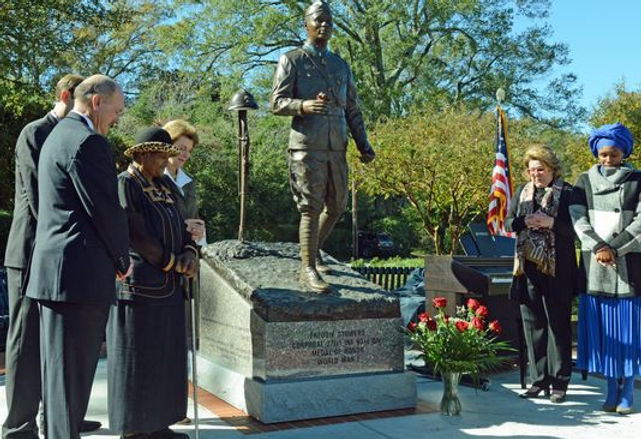
Welcome to the Freddie Stowers Veterans Memorial Park
and the Anderson County Veterans Memorial


September 28, 2018 - This is an historic date for Freddie Stowers and his family. It marked the centennial of his death, and he was the first African American Recipient of the WWI Medal of Honor. Yet, he didn't receive the award until 73 years after he perished during the Battle of Meuse-Argonne.
Born in Sandy Springs, South Carolina, as the grandson of slaves and one of twelve children of Wylie and Annie Stowers. Freddie Stowers life in this small southern town would have been strictly circumscribed by the racial customs of the day. At 21, he was already married to a young woman named Pearl, and a father of one daughter, Minnie, named for one of his sisters. He worked as a farmhand before being drafted into the Army and sworn into service in Williamston on October 4, 1917. where he served with the 371st Infantry Regiment of the 93rd Division, one of only two African American divisions. Before sailing to France, he trained at Camp Jackson (now Fort Jackson) in Columbia, South Carolina, about two hours away from his hometown. At the time in 1917, racial tensions still existed over issues focused on race. This prompted many white southerners to fear the arming and training of mass numbers of African American males. White southern politicians lobbied against using African American men in combat and against placing them in southern training camps. Ultimately, racial prejudice dictated the roles and responsibilities approximately 90% of African American males held during the war, which included loading and unloading cargo, digging trenches, burying bodies, cooking, and chauffeuring. Stowers was among the 10% of African American servicemen from World War I who served in combat. Within two months, he was promoted to private first class and by the spring of 1918, he was assigned to the American Expeditionary Force (AEF), sent to France and promoted to corporal.
FREDDIE STOWERS - FIRST AFRICAN AMERICAN MEDAL OF HONOR RECIPIENT AND HERO
Significance:
African American Soldier,
Medal of Honor recipient, WWI
Place of Birth:
Sandy Springs, South Carolina
Date of Birth: January 12, 1896
Family:
Wife’s Name: Pearl Daughter: Minnie Lee
Two surviving sisters: Georgina Palmer & Mary Bowens
Date of Death: September 28, 1918
Place of Death:
Ardeuil-et-Montfauxelles, Departement des Ardennes,
Champagne-Ardenne, France
Place of Burial:
Romagne-Sous-Montfaucon, France
Cemetery Name:
Meuse-Argonne American Cemetery and Memorial
Donors and family members unveil the statue of Freddie Stowers on the campus of Anderson University. Photo Courtesy: Paul Brown, The Greenville News


In March 1918, General Pershing assigned the 371st Infantry along with other all-Black regiments including the Harlem Hellfighters to aid the beleaguered French forces during World War I. The French needed combat troops and were accustomed to deploying their own Black colonial troops. While American military leaders warned the French not to treat the 371st Infantry and other African Americans as they did white troops, the French ignored this advice and welcomed them into their fighting force. After they received training with French weapons, the 371st was attached to the 157th French Army, known as the “Red Hand Division.”
In the early morning hours of September 28, 1918, Corporal Stowers’s company was ordered to take the heavily defended Hill 188, overlooking Ardeuil-et-Montfauxelles in the Ardennes region of France, from the Germans. The Germans initially gave stiff resistance to the American charge. The Germans used mortars, machine guns, and rifle fire. The Americans continued their determined advance up the hill. Stowers and his comrades saw the Germans wave a white flag and try to surrender. The Americans moved closer to the Germans without firing, readying to take the Germans prisoners. At the last moment the Germans jumped back into their trenches and machine-gun fire again raked the Americans. Half of Stowers’s company was killed or wounded including his lieutenant and higher-ranked non-commissioned officers.


Flag of the French 157th Infantry Division commanded by General Goybet American flag section commemorating the service of the 371st Infantry Regiment (United States) and 372nd Infantry Regiment (United States) in the division.

Corporal Stowers took command of the depleted company and urged them forward. Stowers and the remaining soldiers took the first German trench and neutralized one machine-gun position. As Stowers was leading his men to the second German trench, he was mortally wounded by German machine-gun fire. As he lay wounded, he urged his company forward to overtake the German position. The men forged ahead and dislodged the Germans from Hill 188. Stowers died there that day. He was buried along with 133 of his comrades at the Meuse-Argonne American Cemetery and Memorial east of Romagne-sous-Montfaucon in France.
Following his heroism and being killed in action, Stowers' commanding officer nominated him for the Medal of Honor, but the nomination was never processed. Stowers’s heroic actions laid dormant in the annals of history the mid-1980’s, when an investigation into the lack of African-American Medal of Honor holders for World War I and II led researchers to find Stowers’ original recommendation. The investigation determined Stowers recommendation had fallen through the cracks. On April 24, 1991, President George H.W. Bush posthumously awarded Corporal Freddie Stowers the Medal of Honor at a White House ceremony. Stowers’s two sisters accepted the award on the family’s behalf.


Medal of Honor Citation
Cpl. Freddie Stowers distinguished himself by exceptional heroism on 28 September 1918 while serving as a squad leader in Company C, 371st Infantry Regiment, 93d Infantry Division. His company was the lead company during the attack on Hill 188, Champagne Marne Sector, France, during World War I. A few minutes after the attack began, the enemy ceased firing and began climbing up onto the parapets of the trenches, holding up their arms as if wishing to surrender. The enemy's actions caused the American forces to cease fire and to come out into the open. As the company started forward and when within about 100 meters of the trench line, the enemy jumped back into their trenches and greeted Cpl. Stowers' company with interlocking bands of machine-gun fire and mortar fire causing well over fifty percent casualties. Faced with incredible enemy resistance, Cpl. Stowers took charge, setting such a courageous example of personal bravery and leadership that he inspired his men to follow him in the attack. With extraordinary heroism and complete disregard of personal danger under devastating fire, he crawled forward, leading his squad toward an enemy machine-gun nest which was causing heavy casualties to his company. After fierce fighting, the machine-gun position was destroyed and the enemy soldiers were killed. Displaying great courage and intrepidity Cpl. Stowers continued to press the attack against a determined enemy. While crawling forward and urging his men to continue the attack on a second trench line, he was gravely wounded by machine-gun fire. Although Cpl. Stowers was mortally wounded, he pressed forward, urging on the members of his squad, until he died. Inspired by the heroism and display of bravery of Cpl. Stowers, his company continued the attack against incredible odds, contributing to the capture of Hill 188 and causing heavy enemy casualties. Cpl. Stowers' conspicuous gallantry, extraordinary heroism, and supreme devotion to his men were well above and beyond the call of duty, follow the finest traditions of military service, and reflect the utmost credit on him and the United States Army.
